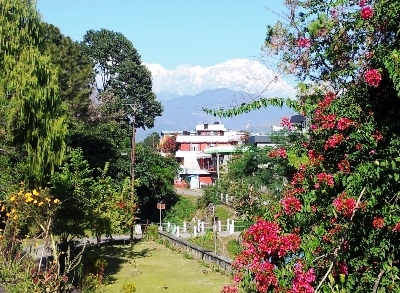[This is the second part of a discussion about Pokhara and its water issues. The first talked about measuring climate in Nepal].
Later that afternoon Nirajan brought us to meet the regional director of water management, the person in charge of Fewa Lake, Krishna Raj Timilsina.
 |
| The water manager is "in" |
From our experience, the size of someone's office in Nepal is proportional to the level of their position. Earlier that day we were in the Immigration office where four people were piled into one room so tightly that one person had to get up and stand outside for the others to get to their desks. The Director's office had the kind of couches and chairs I had usually only seen in diplomatic negotiations. After an assistant brought us tea on a platter, I realized that I was sitting at nearly eye level with the Director's expansive desk. Strangely, I had much the same feeling as when I got into the private washroom of the Australian Bureau of Meteorology's Chief Executive (long story, don't ask).
 |
| Fewa Lake reflects the Himalayas. The lake level gage is to the right. |
Fewa Lake, itself, is natural, but it was enlarged a bit by adding the dam in the 1967. It was built by India and was made of what some called "proto-concrete" (we never did get a good translation...). The Pardi Dam then failed in 1973 (some other sources say 9 years after it was built, others 7 years). Somewhat surprisingly nobody knew of any photos of the old dam or its failure. A few years later another dam was built on a downstream site by the Chinese. There is a hydropower generating station, but it hasn't been functioning in a while. The director said that the lake management strategy was simple; there was a standard operating procedure of keeping the lake level steady.
I think the two dams are a bit iconic of the struggle between India and China to each count Nepal in their sphere of influence. I also think the failure of the dam 40 years ago is an example of how disasters can happen even without the climate misbehaving.
I think the two dams are a bit iconic of the struggle between India and China to each count Nepal in their sphere of influence. I also think the failure of the dam 40 years ago is an example of how disasters can happen even without the climate misbehaving.
 |
| Ruins of the old dam, including its inscription, are still accessible. |
 |
| The newer Fewa Lake dam |
In Nepal, problems were starting to happen in this transition zone, however. The Director told us of people coming down from the hills into the cities because springs were drying up. There are stories of resettlement camps for "Climate Refugees". He talked about how the hydrology had changed since he was young. Decades ago, "the Seti River was very difficult to cross manually by strong men." It was a problem; people would get hurt because the water was so high and fast. "Now it can be crossed by old men like me."
 |
| The skyline above Pokhara |
He was insistent about the issue, coming slightly out of his seat as he shook his finger. He suggested that the hydrology department should analyze their data (indeed, see Dr Sharma's climate change in Nepal book... The really interested reader can even read dissertations published on the effects of climate change on Nepalese hydrology). He said he hasn't analyzed the data himself - he's lived it. He's been all over Nepal for the last 30 years and witnessed the changes first-hand.
"You want to see climate change? Come with me" and we all shuffled out of the office and climbed out onto the roof of his building. "There, look, through the trees.."
 |
| The view from the Director's rooftop |
He pointed to a spot on one of the mountains where there were three long diagonal stripes of ridges where the snow had melted away. It wasn't like that when he was young. That's all new. He reckons that the snow line has gone up about 200 meters in 30 years. He offered that someday instead of "White Himalayas" maybe they'll have "Black Himalayas". [To put these numbers in context, there's probably about 1,000-1,500 meters of snow elevation left to the highest peaks].
"Well, so what are you going to do?" I asked. He shrugged, as if to say "heck if I know".
If you want to see how much Nepal emits, Google has a website that compares emissions by countries and over time. Nepal is already an extremely low emitter. The average US citizen emits about 160 times as much as the average Nepali. Nepal's emissions per person have been flat since about 1997. The US's emissions per person have been flat since 1980.
 |
| Nepal's emissions per person versus time from Google |

No comments:
Post a Comment